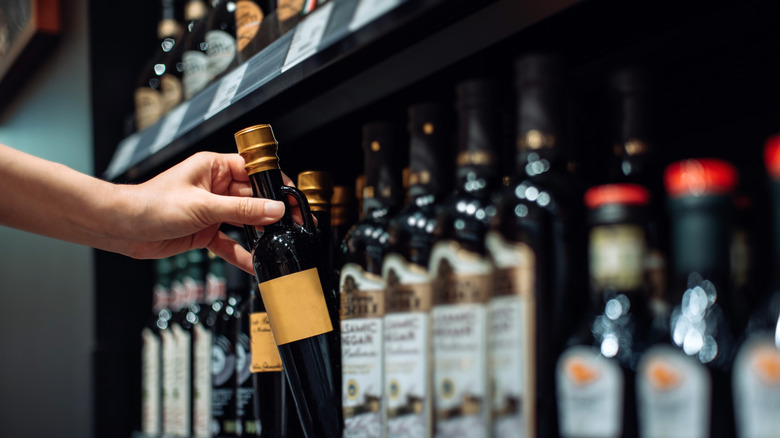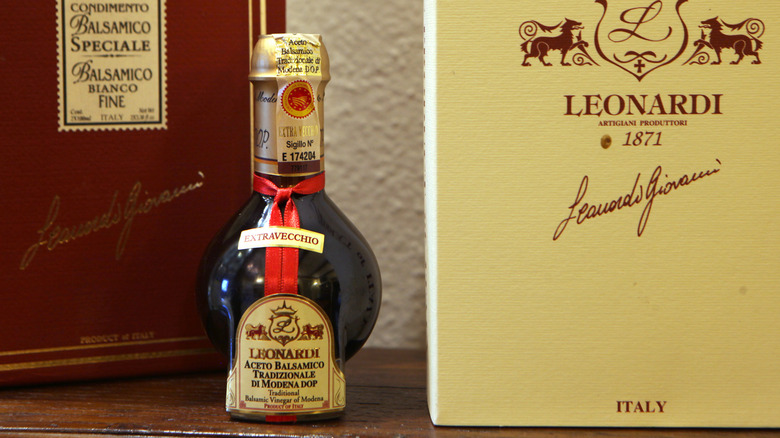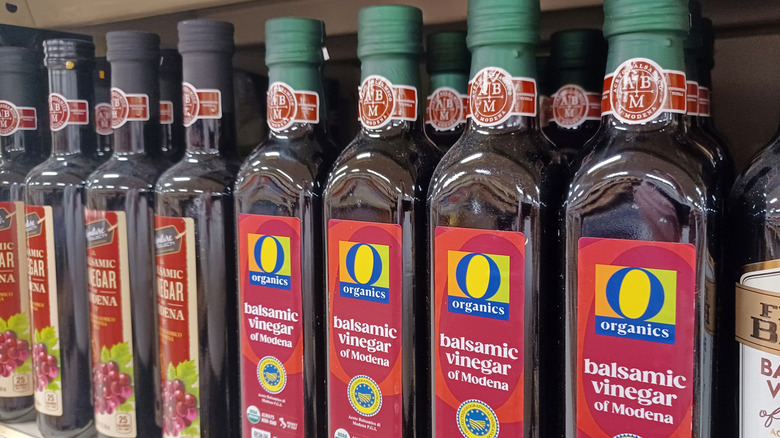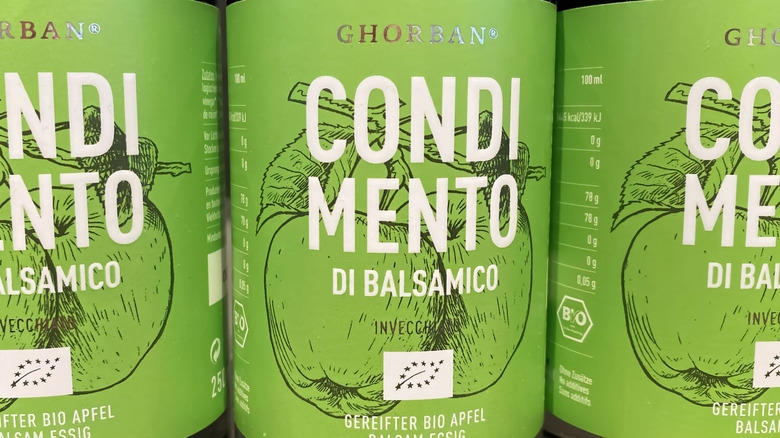Your Store-Bought Balsamic Vinegar Isn't The Real Deal. So What Is It?
Okay: first things first. Let's define "the real deal." According to the United States government, "balsamic vinegar" can mean anything — as long as there's vinegar in there. Merriam-Webster is a little more precise: the dictionary defines it as "an aged Italian vinegar made from the must of white grapes." But, that definition is still a little rough around the edges.
Balsamic vinegar doesn't have to come from Italy (though purists argue otherwise). Like champagne, traditional and authentic balsamic vinegar comes from a specific place: northern Italy's Modena and Reggio Emilia region. And, like champagne, the good stuff has a seal to prove it. Traditional vinegar from Modena or Reggio Emila has a Protected Designation of Origin (PDO) status awarded by the E.U. To get the coveted PDO certification, producers must follow strict regulations and age vinegar for at least 12 years. People often pair traditional balsamic vinegar with fruit — the sweet, syrupy flavor complements fresh berries beautifully.
PDO balsamic vinegar is rich, syrupy, and deeply flavorful. You won't find it at Kroger — but you might find vinegar made in Modena. It'll have a PGI seal, which stands for Protected Geographical Indication. Like PDO vinegar, the seal means that it was made in Modena and meets certain standards. Those standards are much, much looser than PDO vinegar, though. Anything made outside this region falls in the condimento category (basically, anything goes), and the quality varies a lot. So, how can you tell if your balsamic vinegar is real?
What is PDO vinegar?
Why does the best PDO balsamic vinegar come exclusively from Modena? Yeast, for one. The region has a lot of natural yeast in the air, which helps with fermentation. There's also history: balsamic vinegar originated in Modena. Many producers run small, family-owned operations that have been around for hundreds of years. These operations are called acetaias, and they're basically the equivalent of wineries.
In 1860, an Italian nobleman from Modena named Francesco Agazzotti laid down the law — or at least helped establish it. His description of the balsamic vinegar production process served as the basis for today's PDO standards. Producers must follow the same steps Agazzotti described, and they can only use specific grape varieties. If they don't, they won't get that coveted PDO status.
Traditional balsamic vinegar only has one ingredient: grape must, or mosto cotto. Grape must comes from crushed grapes, and it's the first step in making wine, too. Unlike wine, though, the casks aren't sealed: each cask has a hole where juice can evaporate. The longer vinegar ages, the thicker and sweeter it gets. That's how PDO vinegars get their syrupy texture and taste.
What is PGI vinegar?
Let's be honest here: most of us don't need expensive vinegar in our pantries. Even hardcore vinegar fanatics keep cheap stuff on hand. I'm no aficionado: my balsamic vinegar is from Trader Joe's and is PGI, complete with the blue and yellow E.U. seal that confirms it's from Modena. The label waxes poetic about robust flavors and sweet notes, but the grapes are only aged five years, and the first ingredient is wine vinegar.
PGI vinegar needs to contain grape must but producers can dilute it with wine vinegar, which is made through a different process. They can include other additives, too. While PDO vinegar ages for at least 12 years, PGI is good to go after 60 days. However, if producers want to label it "aged" the grapes need to sit around for at least three years.
Vinegar that barely meets that 60-day requirement is tart, watery, and pale, so producers disguise this with food coloring, sweeteners, and thickeners. When you're shopping for balsamic, check the ingredients. If you see things like caramel color on the label, give it a pass.
Some PGI vinegars are flavorful and thoughtfully made, though. They're also pricier, but a good balsamic vinegar is worth it if you can afford to splurge. Look for aged vinegar that came from a specific acetaia and avoid house brands — they're usually poor quality. Sorry, Trader Joe's.
What is condimento?
Condimento refers to all types of balsamic vinegar that are not PDO or PGI. These vinegars are wildcards and producers don't have to follow rules or regulations. However, some condimento vinegar varieties rival the traditional stuff. Sometimes, it even comes from the same facilities. Since condimento vinegar doesn't have to play by the rules, producers can experiment with different grapes, shorter aging periods, and fun flavors.
Condimento also applies to vinegar that wasn't made in Modena. Some come from other parts of Italy, some come from other countries. In 2015, Italian vinegar producers tried to restrict the name "balsamic vinegar" to vinegar made in Italy, but an E.U. court shot them down. Now, some producers in Spain, France, and the U.S. make balsamic vinegar with more or less traditional methods.
Be selective if you don't see that PGI seal — especially if you're buying on a budget. For the bougier balsamics, though, use the same logic as you would for PGI vinegar. Aged balsamic from small, family-owned producers are your best bet for flavor and quality.



